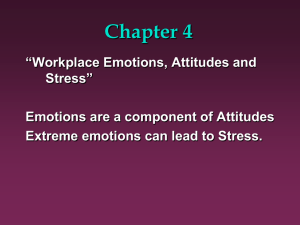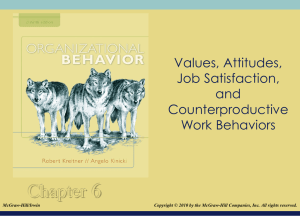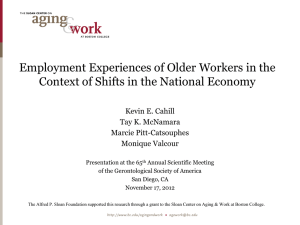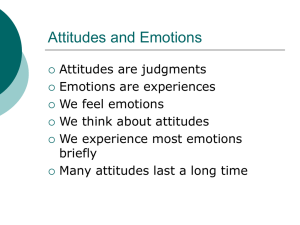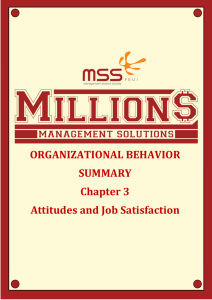Chapter 6 – Work-related attitudes : prejudice, job satisfaction and
advertisement
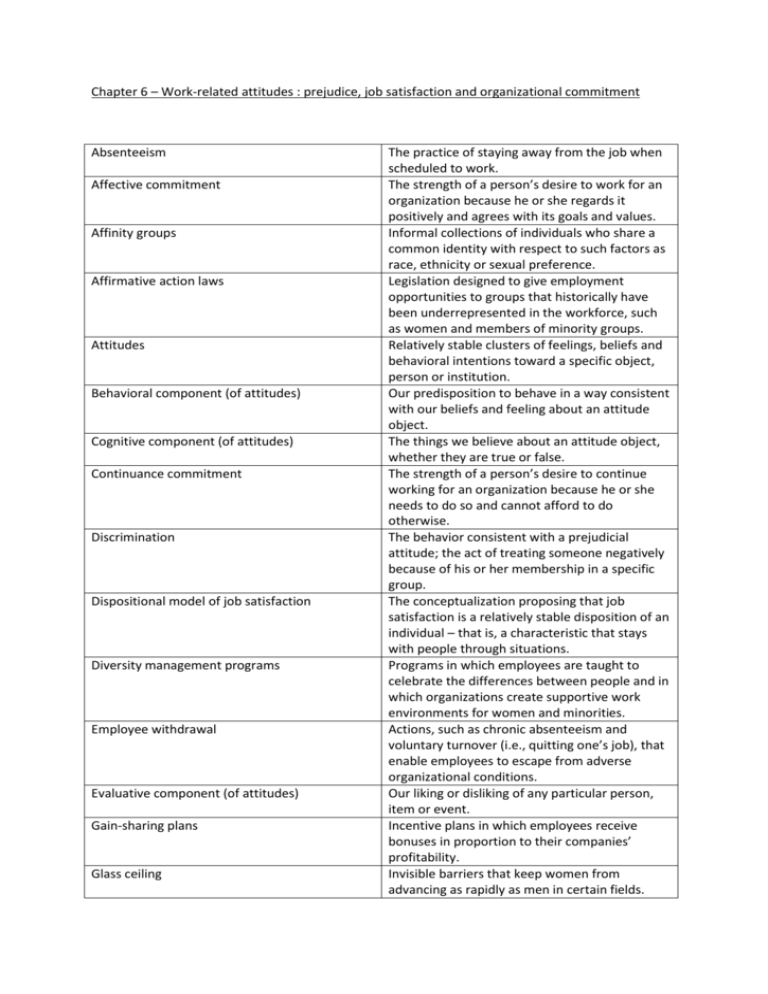
Chapter 6 – Work-related attitudes : prejudice, job satisfaction and organizational commitment Absenteeism Affective commitment Affinity groups Affirmative action laws Attitudes Behavioral component (of attitudes) Cognitive component (of attitudes) Continuance commitment Discrimination Dispositional model of job satisfaction Diversity management programs Employee withdrawal Evaluative component (of attitudes) Gain-sharing plans Glass ceiling The practice of staying away from the job when scheduled to work. The strength of a person’s desire to work for an organization because he or she regards it positively and agrees with its goals and values. Informal collections of individuals who share a common identity with respect to such factors as race, ethnicity or sexual preference. Legislation designed to give employment opportunities to groups that historically have been underrepresented in the workforce, such as women and members of minority groups. Relatively stable clusters of feelings, beliefs and behavioral intentions toward a specific object, person or institution. Our predisposition to behave in a way consistent with our beliefs and feeling about an attitude object. The things we believe about an attitude object, whether they are true or false. The strength of a person’s desire to continue working for an organization because he or she needs to do so and cannot afford to do otherwise. The behavior consistent with a prejudicial attitude; the act of treating someone negatively because of his or her membership in a specific group. The conceptualization proposing that job satisfaction is a relatively stable disposition of an individual – that is, a characteristic that stays with people through situations. Programs in which employees are taught to celebrate the differences between people and in which organizations create supportive work environments for women and minorities. Actions, such as chronic absenteeism and voluntary turnover (i.e., quitting one’s job), that enable employees to escape from adverse organizational conditions. Our liking or disliking of any particular person, item or event. Incentive plans in which employees receive bonuses in proportion to their companies’ profitability. Invisible barriers that keep women from advancing as rapidly as men in certain fields. Hangover effect High-performance work systems Honeymoon effect Honeymoon-hangover effect Inclusion Job satisfaction Nonpreferential affirmative action Normative commitment Organizational commitment Organizational demography Preferential affirmative action Prejudice Religious intolerance Sex-role stereotypes Social information processing model The tendency for people’s levels of satisfaction to drop over time from when a position is brand new to when one gains more experience with it. Organizations that offer employees opportunities to participate in decision making, provide incentives for them to do so, and emphasize opportunities to develop skills. The tendency for people to enjoy high levels of satisfaction on new jobs that they have taken in response to dissatisfaction with their old jobs. The tendency for the honeymoon effect to occur (i.e. for job satisfaction to increase as a dissatisfied person takes a new job) followed by the hangover effect (i.e. for the high levels of satisfaction associated with a new job to decline over time). Making people feel valued as worthwhile members of the organization. Positive or negative attitudes held by individuals toward their jobs. Efforts to get companies to conduct ongoing , conscious appraisals of heir rules and procedures and to eliminate those that exclude women and members of minority groups without sufficient justification. The strength of a person’s desire to continue working for an organization because he or she feels obligations from others to remain there. The extent to which an individual identifies and is involved with his or her organization and/or is unwilling to leave it (see affective commitment, continuance commitment and normative commitment). The nature of the composition of a workforce with respect to various characteristics (e.g. age, gender, ethnic makeup, etc.). The practice of hiring women and members of minority groups in proportion to their representation in the population near organizations. Negative attitudes toward the members of specific groups, based solely on the fact that they are members of those groups (e.g. based on age, race, ethnicity, sexual orientation). Actions (e.g. personal ridicule, vandalism) taken against persons or groups based on their faith. Narrow-minded beliefs about the qualities of women and men and the kinds of tasks for which each is most appropriately suited. A conceptualization specifying that people adopt attitudes and behaviors in keeping with the cues Stereotypes Unfolding model of voluntary turnover Value theory of job satisfaction Voluntary turnover Work-related attitudes provided by others with whom they come into contact. Beliefs that individuals possess certain characteristics because of their membership in certain groups. A conceptualization that explains the cognitive processes through which people make decisions about quitting or staying on their jobs. A theory suggesting that job satisfaction depends primarily on the match between the outcomes individuals value in their jobs and their perceptions about the availability of such outcomes. A form of employee withdrawal in which an individual resigns freely from his or her job. Attitudes relating to any aspect of work or work settings.
